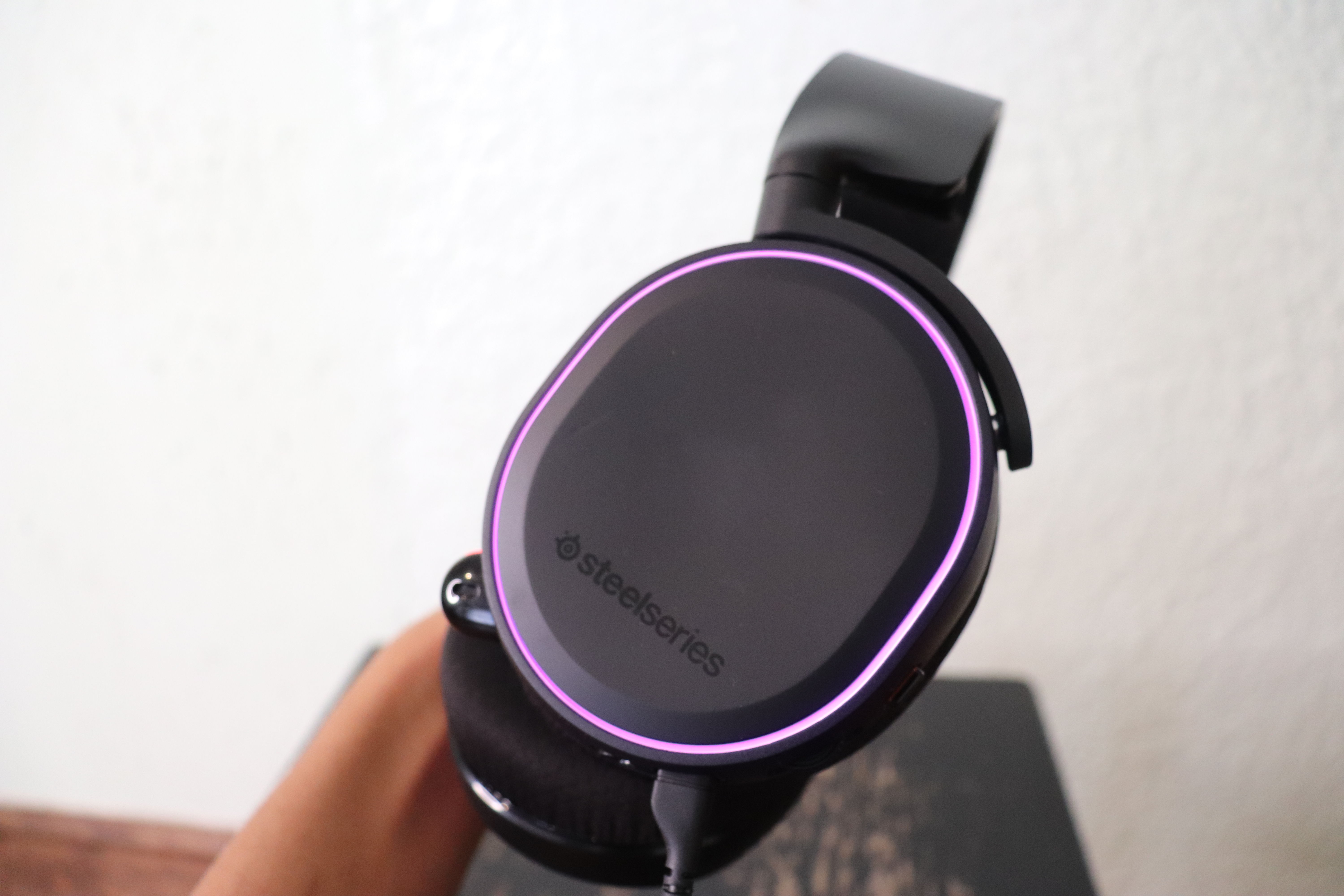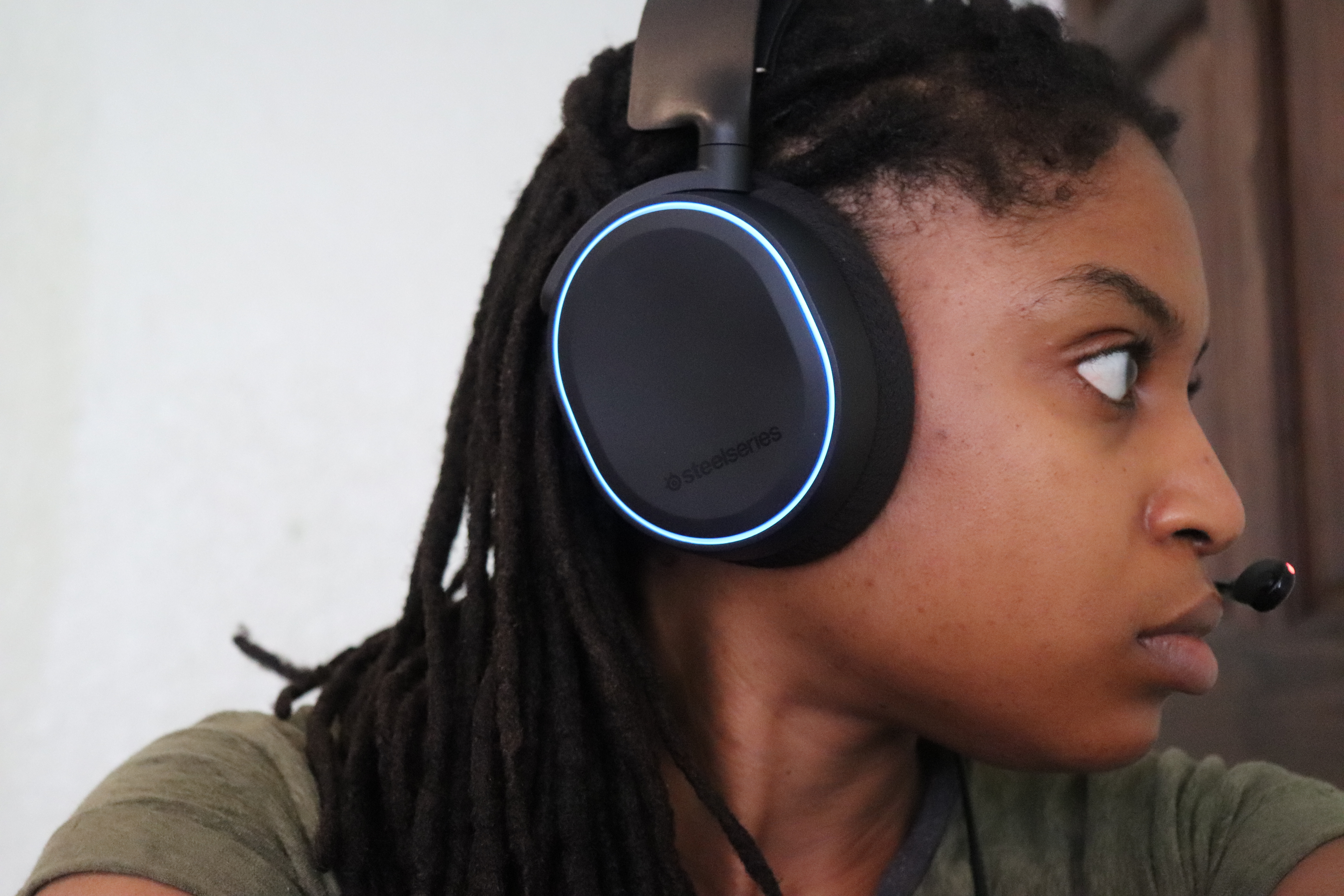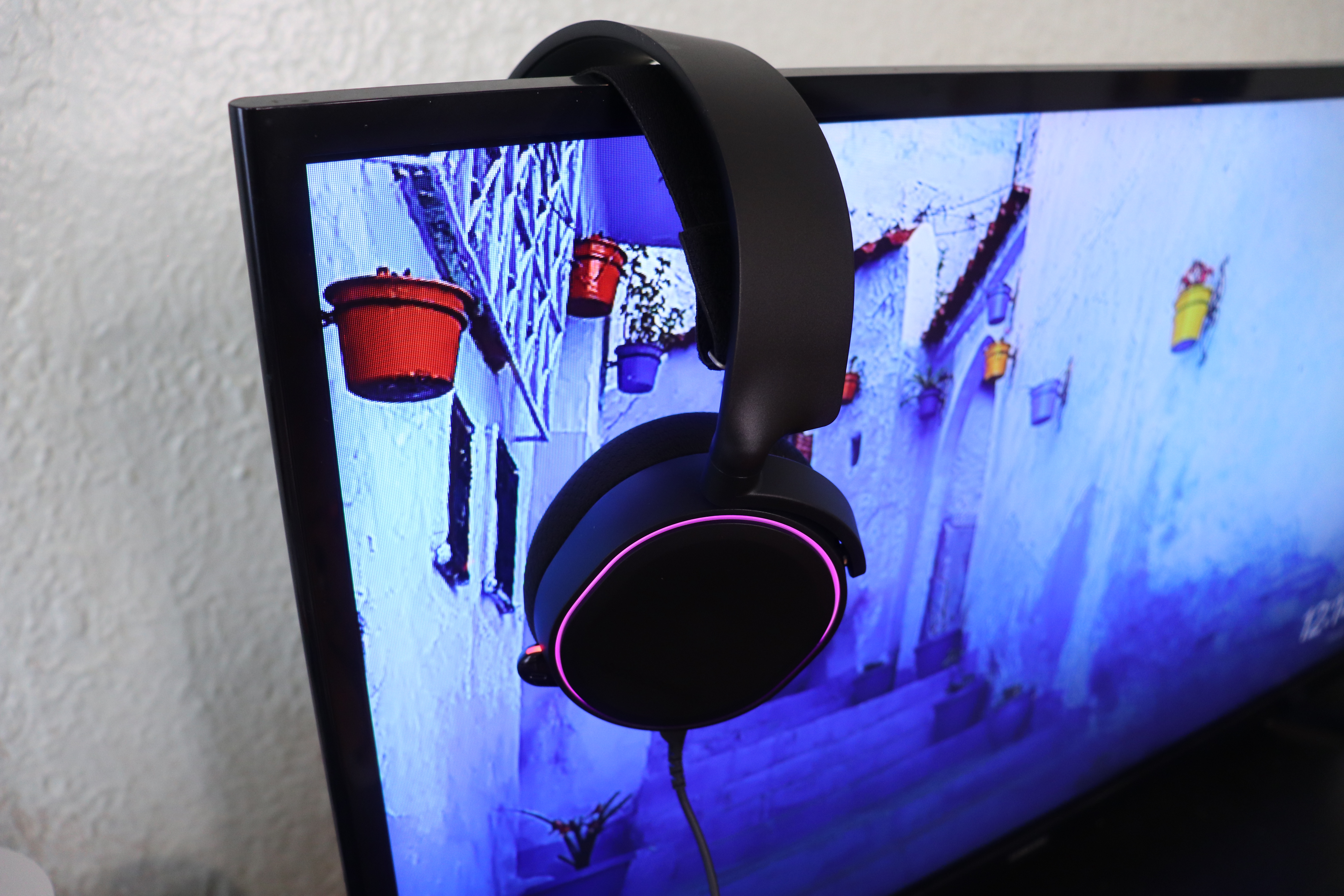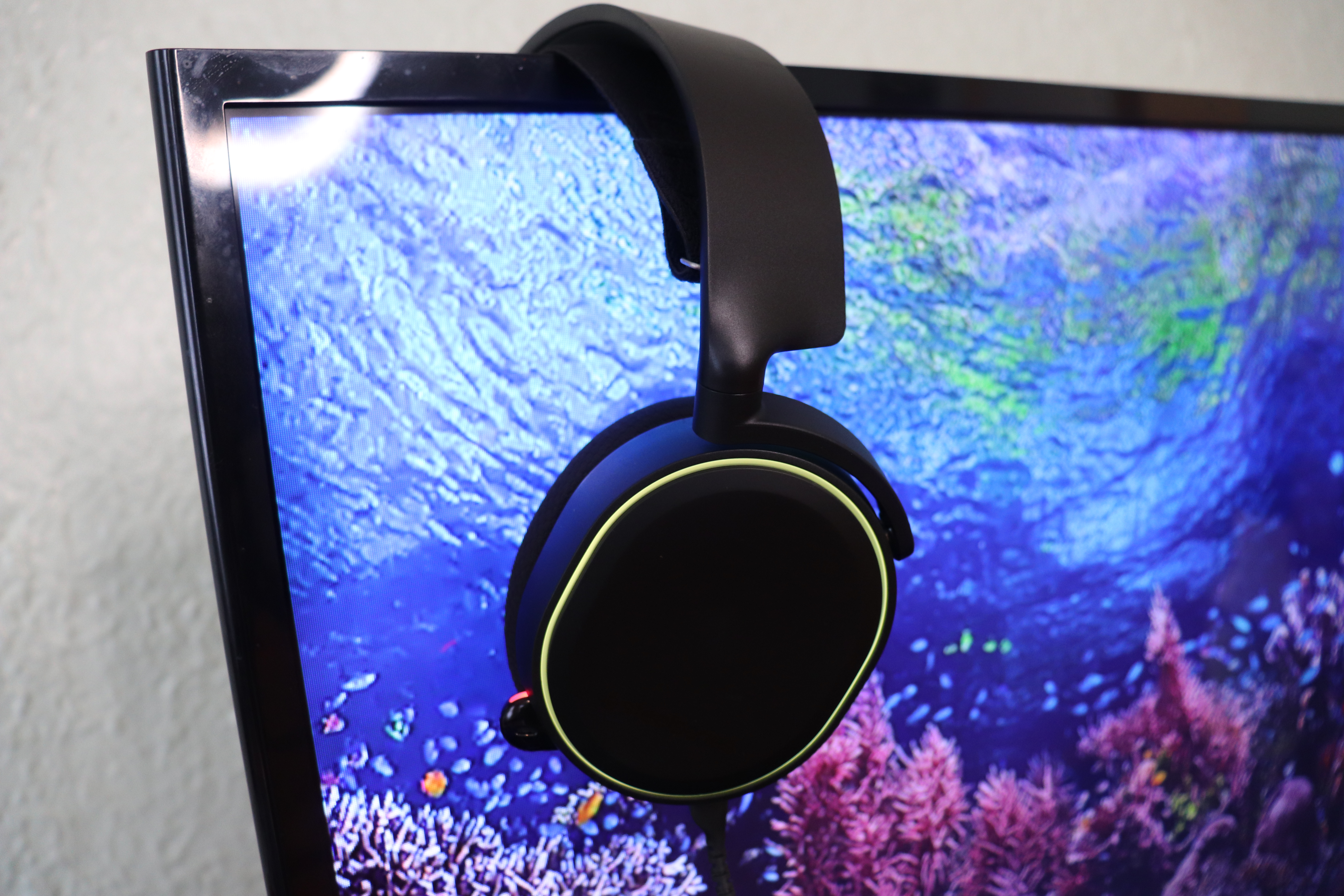Tom's Hardware Verdict
The SteelSeries Arctis 5 is attractive and comfortable, so you’ll be happy to wear it for hours. Great for movies and other media too, its gaming audio is comparable to rivals, though the virtual 7.1 surround sound wasn’t noticeable.
Pros
- +
Simple, yet aesthetically pleasing design
- +
Lightweight and very comfortable
- +
Easily retractable microphone
Cons
- -
Complicated cable system
- -
Virtual surround sound doesn’t do much
Why you can trust Tom's Hardware
The SteelSeries Arctis 5 tries hard to be the best gaming headset. It has a modern design with RGB lighting, a retractable microphone, a ChatMix dial to regulate the volume between a game and its accompanying chat, plus virtual 7.1 surround sound.
At $99 as of writing, SteelSeries’ Arctis 5 headset is compatible with PC, Mac and gaming consoles via USB Type-A and also connects to controllers and smartphones with a 3.5mm adapter. The headset proved decent for gaming, but its audio profile was more impressive for other content, like movies.
SteelSeries Arctis 5 Specs
| Driver Type | 40mm neodymium |
|---|---|
| Impedance | 32 Ohms |
| Frequency Response | 20 Hz - 20 KHz |
| Design Style | Closed-ear design |
| Microphone Type | Bidirectional, retractable, noise cancellation |
| Connectivity | 3.5mm, USB Type-A |
| Weight | 9.76 ounces (277g) |
| Cables | 10 foot (3m) cable, ChatMix Dial USB cable |
| Lighting | 1 RGB zone |
| Software | SteelSeries Engine 3 |
Design of SteelSeries Arctis 5



The SteelSeries Arctis 5 has a simple, modern, look. My review unit came in black, and the headset’s also available in white for a bolder look. But you might not need a white color scheme for that, considering that the Arctis 5 has RGB lighting around the perimeter of the cups.
The lighting has a 10-second color transition by default, but you can customize the effects, including speed, in the Engine 3 software (more on that in the Features and Software section). The lighting remains on as long as the headset is plugged in. It’s a tasteful implementation that won’t stand out as much as the RGB on the JBL Quantum One, for example, but it should still get the job done.
More important than its light show, the headset felt light and comfortable on my head. It features an adjustable strap at the bridge that also does a lot for comfort. I let the strap out a bit to a point where it felt loose, but this wasn’t a negative as the soft cups, which are made of SteelSeries’ Airweave material, have a decent drip.
I didn’t have any issues wearing the SteelSeries Arctis 5 for a few several hours of gaming. The headphones can also swivel flat to be worn around the neck. Weight-wise, the Arctis 5 is on the lighter end at just 9.76 ounces(277g). I noticed a major boost in this comfort between this headset and the Patriot Viper V380, which isn’t that much heavier at 10.88 ounces (310g) but has larger cups and a thicker, braided cord.
Adding to its futuristic design, the Arctis 5 microphone retracts easily from the base of the left cup. It is malleable, allowing for easy adjustment and even turns outward. Setting the mic back in place is as easy as taking it out.
Get Tom's Hardware's best news and in-depth reviews, straight to your inbox.
The controls on the Arctis 5 are simple and include a volume wheel and a mute button for the microphone. The main cable plugs into the ChatMix dial, which then plugs into a PC, Mac, or gaming console via USB Type-A. Users can connect to smartphones and controllers with the 3.5mm adapter.
Unfortunately, the cords are rather long and would get tangled and feel cumbersome while gaming. I had to fold up the remainder of the cord and tuck it behind my gaming PC to keep my space organized.
The good news is that there’s a very comfortable amount of distance between the main cord and the ChatMix dial. This allowed me to keep the dial about an arm’s length away, which is perfect for being able to reach it when necessary and make sure it didn’t interfere with any movements or my best gaming mouse when I didn't need it.
Using the 3.5mm attachment for handheld gaming removes the ChatMix dial but makes the wire much shorter. The 3.5mm attachment is quite small and easy to misplace, so there’s a benefit in putting it away when not in use.
Audio Performance of SteelSeries Arctis 5



The SteelSeries Arctis 5 headset is a decent plug-and-play accessory even before you install the accompanying software. However, in our testing, the ChatMix dial was not functional until the software was set up and the audio ran low until I installed SteelSeries Engine 3 application.
Once I installed the Engine 3 control center, I was able to also adjust the sound with the ChatMix dial. The dial is meant to help users adjust the volume of a voice chat versus the game volume while playing. It also proved to be a decent volume control when consuming other media due to proximity.
I found my ideal audio setup was with my PC audio at maximum and with the hardware and ChatMix dial set at a little above medium. Absolute max, with all three settings at high proved uncomfortable.
There are two audio profiles available within the software: Headset Earphone (Arctis 5 Chat) and Headphones (Arctis 5 Game). The audio difference between the two sound profiles was minuscule. The SteelSeries Arctis 5 Chat profile was slightly louder, but with a lighter pitch, while the Arctis 5 Game profile was slightly deeper and more robust.
One of the SteelSeries Arctis 5’s key features is its virtual 7.1 surround sound, which uses DTS Headphone:X v2.0 (some of SteelSeries other headsets, such as the Arctis 3 use Windows Sonic). As a DTS exec explains on SteelSeries.com, DTS Headphone:X v2.0 “takes a game’s audio from objects or multichannel streams and re-creates them so it no longer is simply basic stereo” for a 3D audio experience.
However, I couldn’t hear any difference between having the 7.1 surround sound on or off in games. This isn’t a massive disappointment, considering the sound quality of the cans without the feature, but the surround sound is also partially what you’re paying for here. Similarly, there wasn’t any obvious difference in having the Stereo profile on or off.
I opted to use the SteelSeries Arctix 5 with virtual 7.1 surround sound off and fired up Destiny 2. I found it challenging to pinpoint various sound details in active battle at Vanguard, unless there were major explosions or gunfire right in front of me. Meanwhile, audio from my Ghost and nearby gamers was loud and clear, even if they weren’t on the screen. In less frantic parts of the game, a lot of the background noise came through like a general hum unless I got up close to different characters, at which point I could more clearly hear conversations.
The SteelSeries Arctis 5 microphone is bidirectional and Discord-certified, and its noise-cancelling features were especially impressive during gameplay. I also used it to chat with friends and family, who confirmed they couldn’t hear the TV show I was playing on my TV in the background. On the other hand, those I chatted with said they could detect music I played at a medium-to-loud level but said it wasn’t a bother. They also reported that other actions, such as claps and stomps I made, sounded faint.
Because it allows you to easily adjust volume, the Chatmix dial will please gamers who are often communicating with their companions on the battleground. I personally didn’t find a major need to use the dial frequently, as I was typically able to hear my teammates’ voices properly without adjusting the dial and vice versa.
Overall, the audio quality during gameplay was decent. I usually kept my volume controls at maximum, where it was loud but just short of uncomfortable. This was my ideal setting, as I felt the urge to increase the volume when I turned it down even a little bit.
I also used the Arctis 5 when I watched the film Maleficent: Mistress of Evil. The headset did well with capturing various details throughout the movie, such as the fluttering of bugs and fairies, water drops bursting, the purring of different animals and the flapping of Maleficent’s wings.
Features and Software on SteelSeries Arctis 5
The SteelSeries Engine 3 software suite is compatible with Windows 7 or newer and macOS 10.10 or newer. The software works with not only the Arctis 5 headset, but also many other SteelSeries keyboards, like the SteelSeries Apex Pro, mice, like the SteelSeries Rival 3, and other SteelSeries peripherals.
As I was setting up the software for the first time with the SteelSeries Arctis 5, the headset was listed first under the Gear section, but users can simply add the Arctis 5 to the accessory list if they are already using Engine 3. Clicking Arctis 5 under the Gear section will bring up its configuration page, which includes a number of customization options, including for surround sound, stereo, bass enhancement, dialogue enhancement, equalizer and dynamic range compression.
Users can also customize the RGB lighting on the Arctis 5’s right and left cups with illumination effects Steady, Color Shift, Multi-Color Breathe or Disable Illumination to turn them off. Other customization options include tweaking the effect timing, patterns and a color picker.
Engine 3 also has a section for apps that allow users to further customize their SteelSeries products. Many of the apps are not for headphones, but one, in particular, is PrismSync, which allows users to project their RGB settings across different devices and accessories. There is also a Library section that allows users to connect their headset settings to individual games.
Bottom Line


The SteelSeries Arctis 5 is an attractive gaming headset that’s light and comfortable with sound profiles that do well with gaming and other types of media too. Gamers won’t be disappointed with this headset, but I preferred how it sounded with movies. While the virtual 7.1 surround sound proved disappointing, which is unfortunate at this price tag, those in regular need of a ChatMix dial will be happy.
For a solid alternate, gamers can consider the Patriot Viper V380. This wired headset also has RGB and a beefier sound profile driven by larger 53mm neodymium drivers. The Viper V380 is priced similarly to our review unit at $75.
Still, the SteelSeries Arctis 5 is a headset gamers will be able to wear for hours with little complaint, making comfort one of its main selling points.
MORE: Best Gaming Headsets
MORE: Gaming Headset Reviews
-
Acurisur This reviewer turned off the 7.1 surround and then goes on to say they had trouble identifying positional sound in Valorant? Well what did they expect would happen? Idiotic thing to do. There's nothing wrong with the 7.1 surround sound, this reviewer just couldn't figure out how to actually use it correctly. It's not the best surround system you can use with this headset (Dolby Atmos for headphones is superior imo but that costs extra) but for out of the box it's still good. The wires are too long if you sit close to where you plug the headset in but my guess is they're trying to accommodate people who sit much further away, such as people who want to game on a console.Reply
